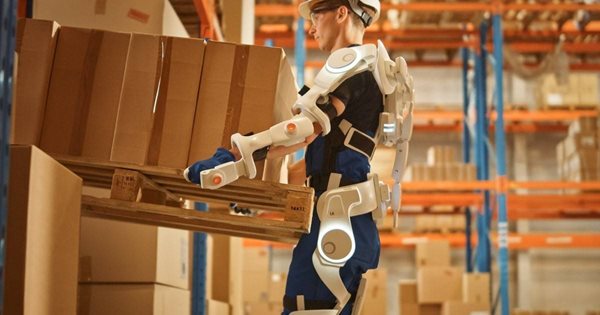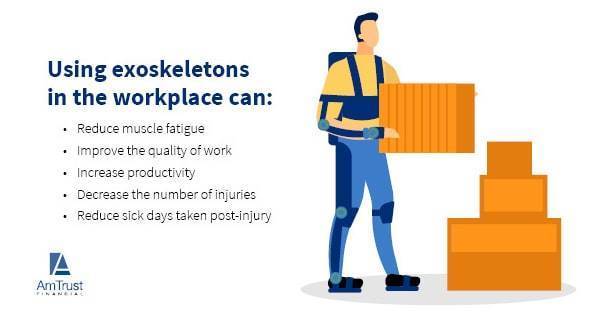Summary: Exoskeleton technology has evolved from its initial use in the military to growing usage in the automotive, warehousing and construction industries. Learn how exoskeleton could improve workplace safety and lower workers’ compensation costs.

Workplace Injuries
The physical demands of a job can lead to costly and debilitating worker injuries. Overexertion is a leading cause of pain, physical disability, missed work, lost productivity and medical expenses.
Back pain is at the top of the list as the most prevalent work-related health problem. Another type of workplace injury is
cumulative trauma disorders (CTDs), long-term musculoskeletal injuries caused by repeated work-related activities.
The most common occupational risks that workers face are injuries from strains and falls. The
2021 AmTrust Contractor Risk Report found that 34% of claims for workplace injuries from plumbers and 27% of claims from electricians were strains, causing an average of 11 days of missed work. Likewise,
AmTrust’s 2019 Retail Risk Report found that retail workers who suffered a strain were out of work an average of 33 days. Retail workers suffered strain injuries due to lifting, pushing, pulling, reaching repetitive motion and using tools and machinery can all contribute to strain injuries. Also, a
U.S. Bureau of Labor Statistics report states that overall workplace injuries due to overexertion and bodily reaction caused on average 34 days away from work.

Exoskeleton Technology
Exoskeleton technology was initially developed for military use in 1965. Since then, exoskeleton usage has expanded into personal healthcare and later into the manufacturing, construction and agricultural industries.
Eksobionic describes exoskeletons as “personal assistive technologies that are designed to affect the body mechanically, reducing the load of physical work, like heavy lifting, while lessening the risk of musculoskeletal disorders.” In other words, exoskeletons are wearable robotic technology that supports workers in their jobs in various industries such as construction, agriculture, services and automotive. They
help reinforce human performance, not replace a missing body part, by augmenting a worker’s hand, lower back or shoulder. When workers wear exoskeleton, the lifted objects seem lighter, and therefore, easier to lift.

There are two major types of exoskeletons: active or powered exoskeletons, which are operated by electric motors, hydraulics or batteries and passive or unpowered exoskeletons, which are propelled by springs, air dampers and human movement.
Exoskeleton Suit for Workers
Occupational exoskeletons technology is a new solution to help reduce a worker’s strain, fatigue, and injury risk.
ABI Research predicts that the exoskeleton market will reach $1.8 billion by 2025, with over 2.6 million suits on the market.
Three common groups of passive exoskeletons currently in use are:
- Back-assist exoskeletons which support the lumbar spine while lifting or holding a load
- Shoulder and arm assist exoskeletons to support the arms and shoulders during sustained overhead work
- Leg-assist exoskeletons that support the ankle, knee or hip joints while carrying a load
The Centers for Disease Control (CDC) found that exoskeletons would help ensure health equity in the workplace. But, exoskeleton configurations must be applicable for a wide range of tasks and ensure fit, comfort and usability for a broad set of users of different sizes, body types, genders and ages. The CDC believes that occupational exoskeletons can reduce the number and associated costs of musculoskeletal injuries in several industries. Back assist exoskeletons were found to reduce back muscle activity by 10-44% during handling tasks, and hip extensor muscle activity was reduced by 24% in laboratory studies.
There could be risks associated with wearing an exoskeleton suit, such as increased chest pressure from wearing the device or shoulder/back discomfort or injury due to an ill-fitting exoskeleton. Passive exoskeletons could
transfer the energy from a vulnerable body part and redirect it to another area. Further testing and case studies of the technology are encouraged.

Exoskeleton Suit Impact on Workers’ Compensation
Occupational exoskeletons are designed to prevent back and shoulder strain injuries. They support workers and
help increase workplace safety when traditional ergonomic controls are not viable.
Exoskeleton devices can impact workers’ compensation insurance in both positive and negative ways, by:
- Decreasing the number of long-term workplace injuries rates. Repetitive motions or awkward work positions can cause a degradation of supporting muscle groups.
- Increasing hidden risks that become apparent after long-term use, which could increase workers’ compensation claims.
- Returning injured employees to work quicker by using this technology.
- Wearing the exoskeleton incorrectly and potentially increasing insurance claims instead of a decreasing.
Major corporations such as Toyota, Ford and Boeing have been using exoskeletons for specific teams in their workforce for nearly ten years. Since then, the company has seen an
83% decrease in injuries in the groups using exoskeleton. Workers experienced minor discomfort, reduced injuries and lowered workers’ compensation costs when using exoskeletons.
Businesses can work with exoskeleton and exosuit manufacturers to design exoskeletons to meet their precise needs. Plus, it is essential for companies to match the suitable exoskeleton device with the employee’s body type and prevalent injuries.
Woody Dwyer, Director of Loss Control at AmTrust explains, “Musculoskeletal Disorders (MSDs) continue to be a leading workers compensation injury. Exoskeletons and exosuits have the potential to reduce ergonomics risk in the workplace where traditional engineering solutions were not technology feasible. Exoskeletons could also support injured workers in their transition back into the workplace and be one component of a robust return to work strategy.”
Return to Work
Exoskeletons could be used to reduce the time injured employees are out of work. An injured worker could use an exoskeleton to assist them with their work until they are fully recovered, and then the wearable technology would be removed. However, while getting a worker back to work sooner is favorable, a worker potentially could use an exoskeleton to return to work earlier than usual, perform the same tasks that caused the initial injury and reinjure him or herself.
“AmTrust recognizes the advancement and growth of exoskeleton and exosuits over the past five years and we are monitoring the development of their standards and their potential for return to work utilization when appropriate,” shares Melissa Burke, Vice President and Head of Managed Care and Clinical.
Reduction of Workers’ Compensation Costs
Workplace injuries have declined over the past decade due to
workplace safety training programs and advances in technology.
Rigid exoskeleton and flexible, textile-based exosuits are becoming a popular investment to ensure worker safety and productivity and ultimately
reduce workers’ compensation costs. The suits can help reduce strain, fatigue from repeated motions and injury risk at the workplace.
As the use of different types of exoskeleton technology increases, the
insurance industry could help facilitate how future generations of workers are protected by promoting long-term studies on the impact of exoskeletons on injury rates and overall costs of usage.
ASTM Committee F48 on Exoskeletons and Exosuits was formed in 2017 to develop voluntary consensus standards for exoskeletons and exosuits.
Work-related musculoskeletal disorders (WMSDs) will continue to be a significant problem and cost for workers, companies, and the insurance industry. As more
studies are released about exoskeleton usage, the positives outweigh the negatives, encouraging companies to include their use as part of their workplace safety and ergonomic programs.

Loss Control Expertise From AmTrust Financial
AmTrust Financial is a leader in workers’ compensation insurance for small to mid-sized businesses. Our Loss Control Department specializes in loss prevention and risk management solutions that improve employee safety. It’s our goal to provide the proper safety resources and commercial property safeguards to ensure your small business thrives. Contact us today to learn more.
This material is for informational purposes only and is not legal or business advice. Neither AmTrust Financial Services, Inc. nor any of its subsidiaries or affiliates represents or warrants that the information contained herein is appropriate or suitable for any specific business or legal purpose. Readers seeking resolution of specific questions should consult their business and/or legal advisors. Coverages may vary by location. Contact your local RSM for more information.